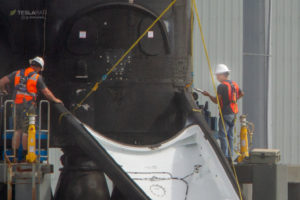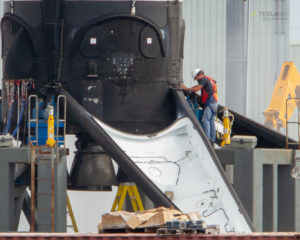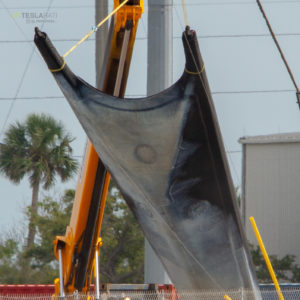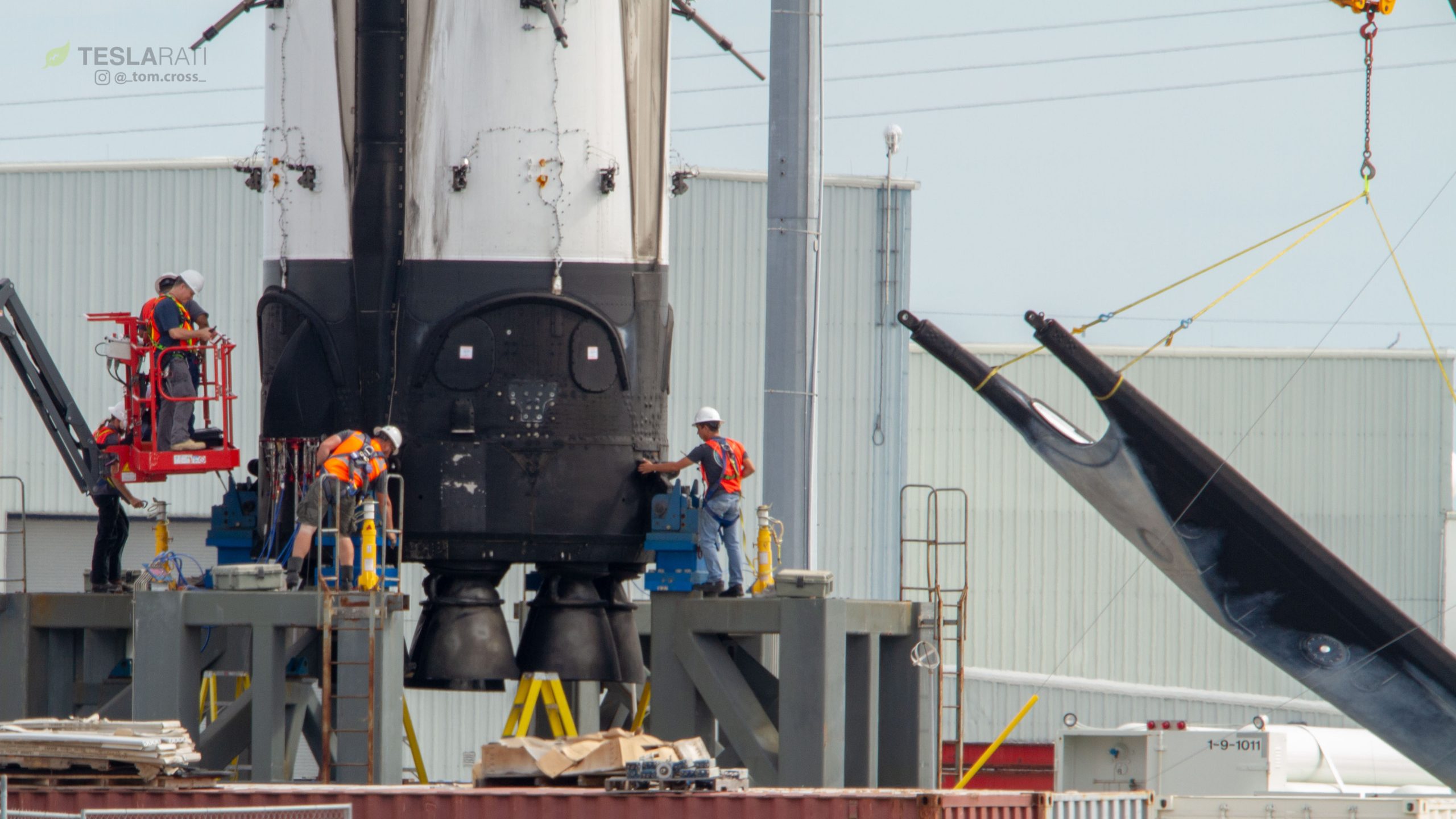
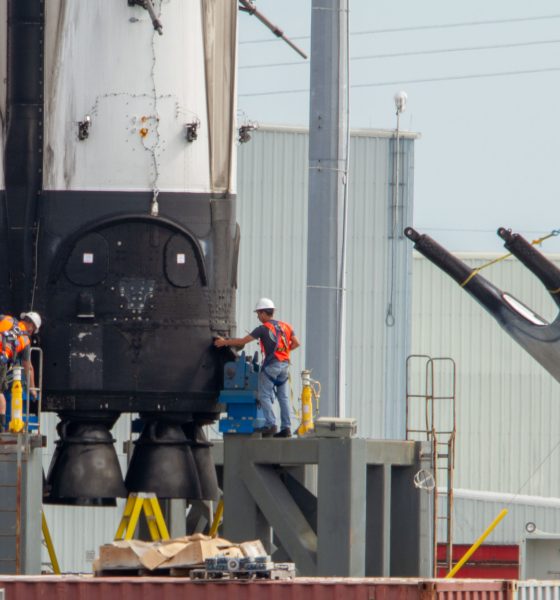
News
SpaceX team spotted removing Block 5 landing legs prior to teardown analysis
Teslarati photographer Tom Cross has captured SpaceX technicians removing the landing legs from the first Falcon 9 Block 5 booster, signaling that the end of recovery operations are near.
Of note, it appears that SpaceX chose to conduct this recovery much like previous ones by removing the rocket’s legs instead of retracting them, a feature of the Block 5 upgrade prominently noted by CEO Elon Musk and other company officials. A brief time-lapse shows workers carefully removing the legs in a well-worn ballet of heavy machinery, skirting around the massive rocket with expertise developed over the better part of two years of sea and land recoveries of Falcon 9 and Falcon Heavy boosters.
There are a number of possible reasons for SpaceX choosing to remove B1046’s landing legs the ‘old-fashioned’ way, most relating to the fact that this particular booster is a critical pathfinder for the entire future of Falcon 9 Block 5. Musk described this attitude in a lengthy and detailed prelaunch briefing:
We are going to be very rigorous in taking this rocket apart and confirming our design assumptions to be confident that it is indeed able to be reused without being taken apart. Ironically, we need to take it apart to confirm that it does not need to be taken apart.
Both COO Shotwell and Musk have briefly discussed the new functionality of the upgraded legs in the past few weeks, indicating that they are capable of being rapidly and repeatedly stowed without being removed from the rocket, whereas all past booster reuse has required the slow removable and equally slow reattachment of landing legs, assuming Block 3 and 4 boosters even reuse their same landing legs. At a minimum, Musk’s above comment already makes it clear that SpaceX has no plans to reuse this booster immediately, instead conducting an extremely thorough teardown analysis to verify that wear and tear from high-speed atmospheric reentry is within an acceptable range.
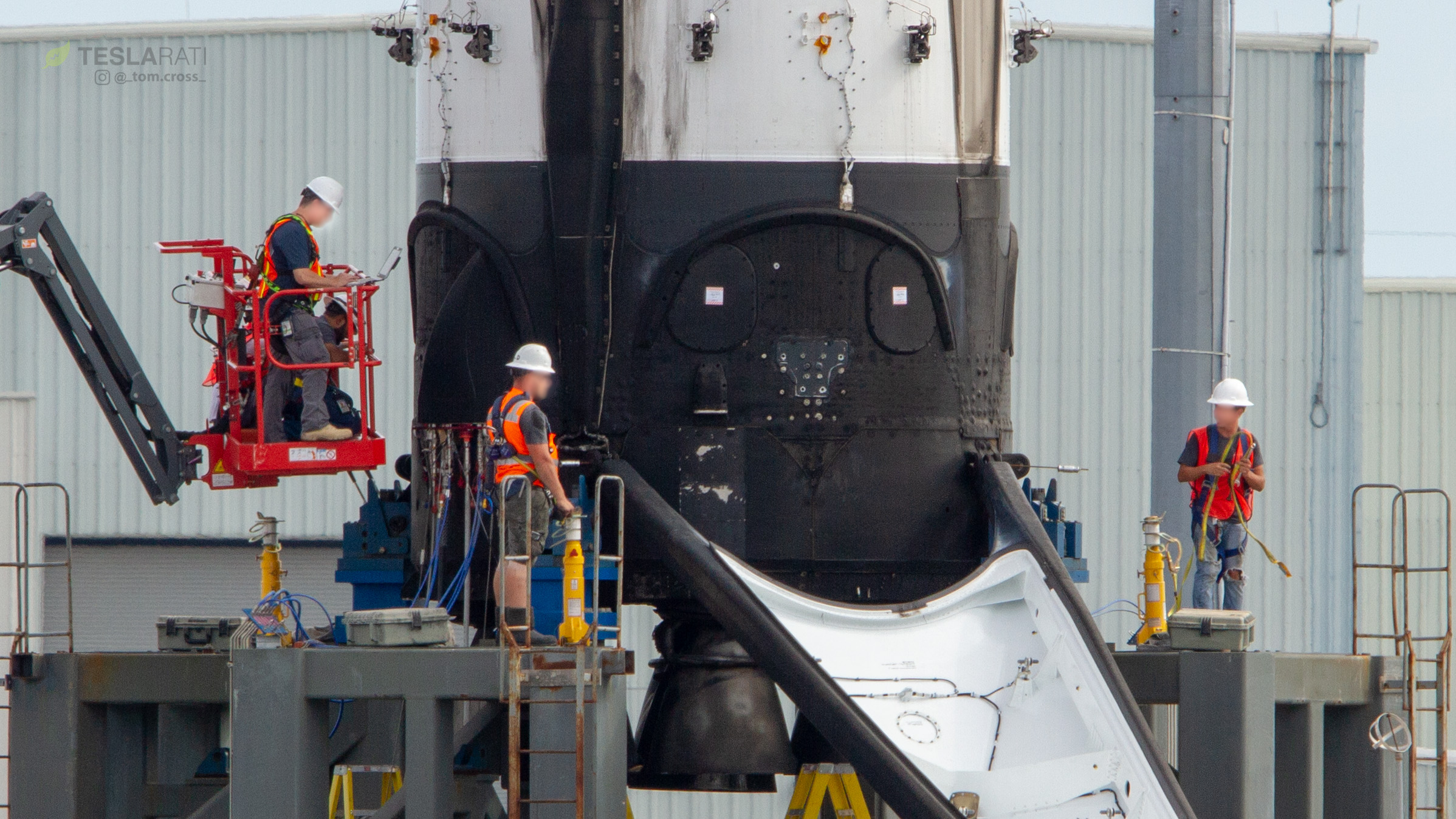
SpaceX technicians busy themselves removing Falcon 9 Block 5’s massive recovery hardware. (Tom Cross)
Equally plausible, choosing to remove B1046’s landing legs instead of testing the new retraction mechanisms may better preserve the leg hardware in its post-landing state, providing engineers and technicians cleaner and more representative data. One final obvious possibility is that the process of flight-testing new Block 5 leg hardware caused damage or led to some off-nominal telemetry and other visible faults, thus preventing them from retracting.
Because the next Block 5 booster (B1047) is likely nearing its own debut after a thorough round of testing in Texas, captured by an aerial photographer, SpaceX may be pushing hard to complete its post-landing analysis of B1046 as quickly as possible to make way for the imminent launches of several new boosters. If the company hopes to maintain its impressive 2018 flight rate of one launch every two weeks throughout the rest of the year, they will need to refly Block 5 boosters at least 10 times – the last flight-proven commercial Block 4 launch (CRS-15) is currently scheduled for early July, leaving roughly half of all 2018’s upcoming launches manifested on Block 5 Falcon 9/Heavy rockets. Falcon Heavy’s second launch has in fact been pushed back by several months per The Planetary Society, indicating that the construction of the first Block 5 center booster has taken a back seat to the more pressing concerns of Falcon 9 Block 5 boosters, upper stages, and fairings needed to avoid additional customer launch delays.

B1046’s final landing leg is removed and carried off with a forklift, presumably for teardown analysis at a SpaceX facility. (Tom Cross)
Regardless, the first successful and nearly-complete recovery of a Falcon 9 Block 5 booster marks a huge milestone for SpaceX. So long as the imminent teardown analysis does not reveal anything especially unexpected, the rocket company is quickly closing in on true rapid reuse with Octagrabber/Roomba’s steady routinization of robotic rocket saving, yet another intact fairing half recovery, and the good condition of B1046 after a relatively hot reentry and landing.
- Just boopin’ an orbital-class rocket with a huge metal component, NBD. (Tom Cross)
- (Tom Cross)
- A toasty Block 5 landing leg shows off a new patina for SpaceX’s upgraded thermal protection material.
- (Tom Cross)
Follow us for live updates, behind-the-scenes sneak peeks, and a sea of beautiful photos from our East and West coast photographers.
Teslarati – Instagram – Twitter
Tom Cross – Twitter
Pauline Acalin – Twitter
Eric Ralph – Twitter

News
Tesla FSD V14.2.1 is earning rave reviews from users in diverse conditions
Tesla’s Full Self-Driving (Supervised) software continues its rapid evolution, with the latest V14.2.1 update drawing widespread praise.

Tesla’s Full Self-Driving (Supervised) software continues its rapid evolution, with the latest V14.2.1 update drawing widespread praise for its smoother performance and smarter decision-making.
Videos and firsthand accounts from Tesla owners highlight V14.2.1 as an update that improves navigation responsiveness, sign recognition, and overall fluidity, among other things. Some drivers have even described it as “more alive than ever,” hinting at the system eventually feeling “sentient,” as Elon Musk has predicted.
FSD V14.2.1 first impressions
Early adopters are buzzing about how V14.2.1 feels less intrusive while staying vigilant. In a post shared on X, Tesla owner @LactoseLunatic described the update as a “huge leap forward,” adding that the system remains “incredibly assertive but still safe.”
Another Tesla driver, Devin Olsenn, who logged ~600 km on V14.2.1, reported no safety disengagements, with the car feeling “more alive than ever.” The Tesla owner noted that his wife now defaults to using FSD V14, as the system is already very smooth and refined.
Adverse weather and regulatory zones are testing grounds where V14.2.1 shines, at least according to testers in snow areas. Tesla watcher Sawyer Merritt shared a video of his first snowy drive on unplowed rural roads in New Hampshire, where FSD did great and erred on the side of caution. As per Merritt, FSD V14.2.1 was “extra cautious” but it performed well overall.
Sign recognition and freeway prowess
Sign recognition also seemed to show improvements with FSD V14.2.1. Longtime FSD tester Chuck Cook highlighted a clip from his upcoming first-impressions video, showcasing improved school zone behavior. “I think it read the signs better,” he observed, though in standard mode, it didn’t fully drop to 15 mph within the short timeframe. This nuance points to V14.2.1’s growing awareness of temporal rules, a step toward fewer false positives in dynamic environments.
FSD V14.2.1 also seems to excel in high-stress highway scenarios. Fellow FSD tester @BLKMDL3 posted a video of FSD V14.2.1 managing a multi-lane freeway closure due to a police chase-related accident. “Perfectly handles all lanes of the freeway merging into one,” the Tesla owner noted in his post on X.
FSD V14.2.1 was released on Thanksgiving, much to the pleasant surprise of Tesla owners. The update’s release notes are almost identical to the system’s previous iteration, save for one line item read, “Camera visibility can lead to increased attention monitoring sensitivity.”
News
Tesla FSD Supervised ride-alongs in Europe begin in Italy, France, and Germany
The program allows the public to hop in as a non-driving observer to witness FSD navigate urban streets firsthand.

Tesla has kicked off passenger ride-alongs for Full Self-Driving (Supervised) in Italy, France and Germany. The program allows the public to hop in as a non-driving observer to witness FSD navigate urban streets firsthand.
The program, detailed on Tesla’s event pages, arrives ahead of a potential early 2026 Dutch regulatory approval that could unlock a potential EU-wide rollout for FSD.
Hands-Off Demos
Tesla’s ride-along invites participants to “ride along in the passenger seat to experience how it handles real-world traffic & the most stressful parts of daily driving, making the roads safer for all,” as per the company’s announcement on X through its official Tesla Europe & Middle East account.
Sign-ups via localized pages offer free slots through December, with Tesla teams piloting vehicles through city streets, roundabouts and highways.
“Be one of the first to experience Full Self-Driving (Supervised) from the passenger seat. Our team will take you along as a passenger and show you how Full Self-Driving (Supervised) works under real-world road conditions,” Tesla wrote. “Discover how it reacts to live traffic and masters the most stressful parts of driving to make the roads safer for you and others. Come join us to learn how we are moving closer to a fully autonomous future.”
Building trust towards an FSD Unsupervised rollout
Tesla’s FSD (Supervised) ride-alongs could be an effective tool to build trust and get regular car buyers and commuters used to the idea of vehicles driving themselves. By seating riders shotgun, Tesla could provide participants with a front row seat to the bleeding edge of consumer-grade driverless systems.
FSD (Supervised) has already been rolled out to several countries, such as the United States, Canada, Australia, New Zealand, and partially in China. So far, FSD (Supervised) has been received positively by drivers, as it really makes driving tasks and long trips significantly easier and more pleasant.
FSD is a key safety feature as well, which became all too evident when a Tesla driving on FSD was hit by what seemed to be a meteorite in Australia. The vehicle moved safely despite the impact, though the same would likely not be true had the car been driven manually.
News
Swedish union rep pissed that Tesla is working around a postal blockade they started
Tesla Sweden is now using dozens of private residences as a way to obtain license plates for its vehicles.

Two years into their postal blockade, Swedish unions are outraged that Tesla is still able to provide its customers’ vehicles with valid plates through various clever workarounds.
Seko chairman Gabriella Lavecchia called it “embarrassing” that the world’s largest EV maker, owned by CEO Elon Musk, refuses to simply roll over and accept the unions’ demands.
Unions shocked Tesla won’t just roll over and surrender
The postal unions’ blockade began in November 2023 when Seko and IF Metall-linked unions stopped all mail to Tesla sites to force a collective agreement. License plates for Tesla vehicles instantly became the perfect pressure point, as noted in a Dagens Arbete report.
Tesla responded by implementing initiatives to work around the blockades. A recent investigation from Arbetet revealed that Tesla Sweden is now using dozens of private residences, including one employee’s parents’ house in Trångsund and a customer-relations staffer’s home in Vårby, as a way to obtain license plates for its vehicles.
Seko chairman Gabriella Lavecchia is not pleased that Tesla Sweden is working around the unions’ efforts yet again. “It is embarrassing that one of the world’s largest car companies, owned by one of the world’s richest people, has sunk this low,” she told the outlet. “Unfortunately, it is completely frivolous that such a large company conducts business in this way.”
Two years on and plates are still being received
The Swedish Transport Agency has confirmed Tesla is still using several different workarounds to overcome the unions’ blockades.
As noted by DA, Tesla Sweden previously used different addresses to receive its license plates. At one point, the electric vehicle maker used addresses for car care shops. Tesla Sweden reportedly used this strategy in Östermalm in Stockholm, as well as in Norrköping and Gothenburg.
Another strategy that Tesla Sweden reportedly implemented involved replacement plates being ordered by private individuals when vehicles change hands from Tesla to car buyers. There have also been cases where the police have reportedly issued temporary plates to Tesla vehicles.

